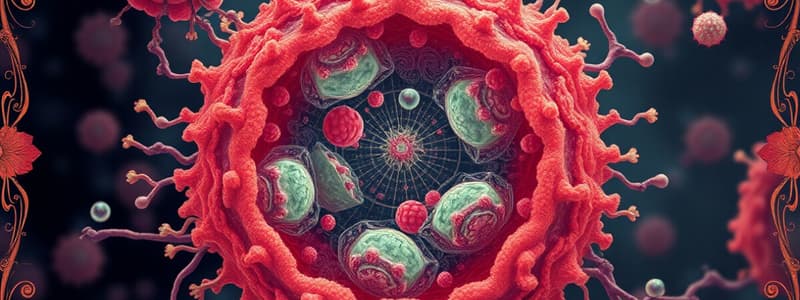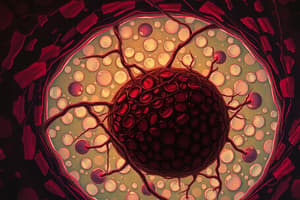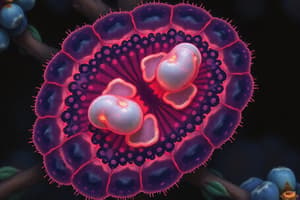Podcast
Questions and Answers
What primarily distinguishes malignant tumors from benign tumors?
What primarily distinguishes malignant tumors from benign tumors?
- Benign tumors interfere with enzyme production.
- Malignant tumors can invade neighboring tissues. (correct)
- Benign tumors can metastasize.
- Malignant tumors grow only locally.
Cancer cells can reproduce infinitely without undergoing apoptosis.
Cancer cells can reproduce infinitely without undergoing apoptosis.
True (A)
What is metastasis in the context of cancer?
What is metastasis in the context of cancer?
The movement of cancer cells to different parts of the body.
A ______ tumor has cells that stay together and do not invade surrounding tissues.
A ______ tumor has cells that stay together and do not invade surrounding tissues.
Match the following characteristics with the correct type of cells:
Match the following characteristics with the correct type of cells:
Which of the following is NOT a characteristic of cancer cells?
Which of the following is NOT a characteristic of cancer cells?
All tumors formed by cancer cells are benign.
All tumors formed by cancer cells are benign.
What percentage of lung cancer cases in Canadians over 40 is attributed to smoking?
What percentage of lung cancer cases in Canadians over 40 is attributed to smoking?
Cancer screening can prevent cancer from developing.
Cancer screening can prevent cancer from developing.
Name one cancer screening method recommended for women.
Name one cancer screening method recommended for women.
Carcinogens in smoke affect more than just the ______.
Carcinogens in smoke affect more than just the ______.
Match the following lifestyle choices with their cancer risk reduction effects:
Match the following lifestyle choices with their cancer risk reduction effects:
Which of the following is not a self-examination method for cancer?
Which of the following is not a self-examination method for cancer?
The diameter of a mole is one of the ABCD criteria used to assess its risk.
The diameter of a mole is one of the ABCD criteria used to assess its risk.
What imaging technology is used specifically to screen for colon cancer?
What imaging technology is used specifically to screen for colon cancer?
A symptom of cancer may include unusual ______ loss.
A symptom of cancer may include unusual ______ loss.
What is one of the reasons cancer is considered a dangerous disease?
What is one of the reasons cancer is considered a dangerous disease?
Benign tumors operate similarly to malignant tumors in how they affect surrounding cells.
Benign tumors operate similarly to malignant tumors in how they affect surrounding cells.
What are the changes in DNA that can cause cancer called?
What are the changes in DNA that can cause cancer called?
Cells from an original tumor can break through the blood vessel walls and travel to other areas of the body, establishing a __________ tumor.
Cells from an original tumor can break through the blood vessel walls and travel to other areas of the body, establishing a __________ tumor.
Match the type of tumor to its description:
Match the type of tumor to its description:
Which factors are known to cause mutations that may lead to cancer?
Which factors are known to cause mutations that may lead to cancer?
Genetic predisposition guarantees that a person will develop cancer.
Genetic predisposition guarantees that a person will develop cancer.
What process do cancerous cells undergo to multiply uncontrollably?
What process do cancerous cells undergo to multiply uncontrollably?
Cancer cells can travel through the body via the __________ system.
Cancer cells can travel through the body via the __________ system.
Which of the following is NOT a characteristic of malignant tumors?
Which of the following is NOT a characteristic of malignant tumors?
Flashcards
Cancer Cell
Cancer Cell
A cell that continues to divide without regard to signals from the body, leading to uncontrolled growth and the formation of a tumor.
Benign Tumor
Benign Tumor
A mass of cells that stays together in one location and does not invade other tissues. It is not cancerous.
Malignant Tumor
Malignant Tumor
A mass of cells that spreads to other parts of the body and interferes with the function of surrounding tissues. It is cancerous.
Metastasis
Metastasis
Signup and view all the flashcards
Apoptosis
Apoptosis
Signup and view all the flashcards
Mitosis
Mitosis
Signup and view all the flashcards
Unlimited Reproduction
Unlimited Reproduction
Signup and view all the flashcards
What causes lung cancer?
What causes lung cancer?
Signup and view all the flashcards
What is cancer screening?
What is cancer screening?
Signup and view all the flashcards
What is genetic screening for cancer?
What is genetic screening for cancer?
Signup and view all the flashcards
What are some examples of cancer screening for women and men?
What are some examples of cancer screening for women and men?
Signup and view all the flashcards
What screening methods are used for colon cancer?
What screening methods are used for colon cancer?
Signup and view all the flashcards
What is the ABCD of moles?
What is the ABCD of moles?
Signup and view all the flashcards
What are some healthy lifestyle choices for reducing cancer risk?
What are some healthy lifestyle choices for reducing cancer risk?
Signup and view all the flashcards
What are some common symptoms of cancer?
What are some common symptoms of cancer?
Signup and view all the flashcards
What is an endoscopy?
What is an endoscopy?
Signup and view all the flashcards
What is a secondary tumor?
What is a secondary tumor?
Signup and view all the flashcards
What is the difference between a malignant and benign tumor?
What is the difference between a malignant and benign tumor?
Signup and view all the flashcards
What is metastasis?
What is metastasis?
Signup and view all the flashcards
What are mutations?
What are mutations?
Signup and view all the flashcards
What are carcinogens?
What are carcinogens?
Signup and view all the flashcards
What is uncontrolled cell proliferation?
What is uncontrolled cell proliferation?
Signup and view all the flashcards
What is mitosis and cytokinesis?
What is mitosis and cytokinesis?
Signup and view all the flashcards
What is cell division?
What is cell division?
Signup and view all the flashcards
What is heredity?
What is heredity?
Signup and view all the flashcards
Study Notes
Cell Division Going Wrong: Cancer
- Cancer is uncontrolled cell division
- A cancer cell continues dividing despite signals from the nucleus or surrounding cells to stop growing and dividing
- Uncontrolled growth forms a lump or tumor
Cell Growth Rates and Cancer
- Cancer cells are large, variably shaped, and have many dividing cells with disorganized arrangement
- Normal cells have a variation in size and shape, with loss of normal features.
Normal Cells vs. Cancerous Cells
- Normal Cells: Many cells that continue to grow and divide with variations in size and shape of cells
- Cancerous Cells: Nucleus that is larger and darker than normal, abnormal number of chromosomes arranged in a disorganized fashion, cluster of cells without a boundary.
Normal Cell vs. Cancer Cell
- Normal Cells:
- Make exact copies through mitosis
- Reproduce for about 50-60 cell divisions
- Stick together to form masses
- Self-destruct when damaged
- Cancer Cells:
- Make exact copies through mitosis
- Do not stop reproducing
- Do not stick to other cells; behave independently
- May move to another location in the body
Normal vs. Cancer Cell (Diagram)
- Diagram contrasting normal cell division (apoptosis) with uncontrolled cancer cell division (b).
Cell Growth Rates and Cancer - Benign Tumors
- Benign tumor: cells of a tumor that stay together and have no serious effect on surrounding tissues, except for crowding them
- Not cancerous, grow only locally and cannot spread by invasion or metastasis
Cell Growth Rates and Cancer - Malignant Tumors
- Malignant tumor: a mass of cells that interferes with functions of neighboring cells and tissues
- Can interfere with hormones or enzymes or destroy surrounding tissues
- Cancerous; cells invade neighboring tissues, invade blood vessels, and metastasize
Benign vs. Malignant Tumors (Summary)
- Benign: tumor cells grow only locally and cannot spread by invasion or metastasis
- Malignant: cells invade, enter blood vessels, and metastasize to different sites
Metastasis
- Metastasis: when cancer cells break away from the original tumor and move to another part of the body
- If the cells settle, they can start another tumor
- This process is dangerous because it accounts for one of the reasons cancer is a dangerous disease.
Metastasis (Diagram)
- Diagram illustrating the process of metastasis, showing cells breaking away and forming new tumors
Causes of Cancer
- DNA Replication: Every cell division duplicates its DNA. Normally the genetic information is identical to the parent cell, however, sometimes random changes called mutations occur.
- These mutations can lead to the cancer cell behaving abnormally, causing repeated uncontrolled cell division until nutrients are depleted and cell growth stops.
Causes of Cancer - Contributing Factors
- Mutations are caused by carcinogens, such as tobacco smoke, radiation, viruses, chemicals, and some organic solvents.
Causes of Cancer - Heredity
- Some cancers may be partially hereditary. Some DNA passed down from one generation to another may lead to disease. Examples include breast and colon cancers.
- A genetic link makes developing certain cancers more likely but it does not guarantee developing cancer
Smoking and Cancer
- Lung cancer is a prevalent cancer type in people over 40
- Smoking is responsible for 90% of lung cancer cases.
- Carcinogens in smoke affect organs other than just the lungs.
- Most smoking related cancers can be avoided by quitting or abstaining from smoking and exposure to secondhand smoke
Cancer Screening
- Cancer screening involves checking for cancer, even without symptoms
- Often done at home or doctors' offices
- Important for people with family history of certain cancers (breast and colon)
- Genetic screening can identify inherited DNA linked to cancer.
- Screening increases the chance for early cancer detection and successful treatment
Taking Responsibility for Health
- Women: Breast self-exams to check for lumps, Pap tests for cervical cancer
- Men: Testicular self-exams for testicular cancer, PSA tests for prostate cancer (age 50+)
- All: Blood tests for colon cancer, regular skin checks by a doctor or dermatologist; using ABCD of moles for self-examination (Asymmetry, Border, Color, Diameter) for potential skin cancers/moles
Reducing Your Risk of Cancer
- Prevention and early detection
- Healthy diet: fruits, vegetables, limited fatty meats, certain "superfoods" (tomatoes, etc.)
- Healthy weight & exercise: maintaining a healthy weight and regular exercise can reduce risk of some cancers.
Diagnosing Cancer
- Symptoms: Swelling, discomfort, fatigue, or unexplained weight loss
- Early diagnosis increases chances of successful treatment.
Imaging Technologies
- Endoscopy: Used to examine colon cancer
- X-rays: Examine bones and lungs, though can damage DNA in rapidly dividing cells. Other body parts like bones and lungs, damage can sometimes occur, particularly to rapidly dividing cells (including a growing fetus).
- Ultrasound: Creates digital image of soft tissues like the heart and liver.
- CT Scan: Uses multiple X-rays from different angles to view specific body areas.
Imaging Technologies - continued
- MRI: uses radio waves and a strong magnetic field to create detailed images of internal body structures.
Examining Cells
- Blood cells: Blood samples can help detect abnormalities like leukemia
- Tumor cells: Biopsy allows viewing the structure and testing for genetic abnormalities.
Cancer Cell Characteristics
- Cancer cells are often irregularly shaped and can sometimes be smaller or larger than surrounding cells
- Diagnosis often involves determining tumor origins, growth rates and spread, to better understand if and how the treatment will be effective and to predict patient outcome
Treatment for Cancer
- Surgery: Physically removing the cancerous tissue; works well when the tumor is easily accessible
- Chemotherapy: Uses drugs to slow or stop cancer cell growth and division, often targeting rapidly dividing cancerous cells
- Radiation: Damages DNA in cancerous cells, minimising side effects by concentrating the radiation beam on the tumor
- Biophotonics: Uses light beams for detection and treatment of cancerous cells. Offers fewer side effects than traditional radiation because the light beam can more effectively target the cancerous cell.
- Genomics: Identify gene mutations, aiming to create personalized and effective cancer treatments which focuses on the genetic drivers behind the cancer.
Studying That Suits You
Use AI to generate personalized quizzes and flashcards to suit your learning preferences.
Related Documents
Description
Explore the mechanisms of cell division and how it can lead to cancer. This quiz examines the differences between normal and cancerous cells, including their structure and growth patterns. Test your knowledge on how uncontrolled cell division occurs and its implications.




